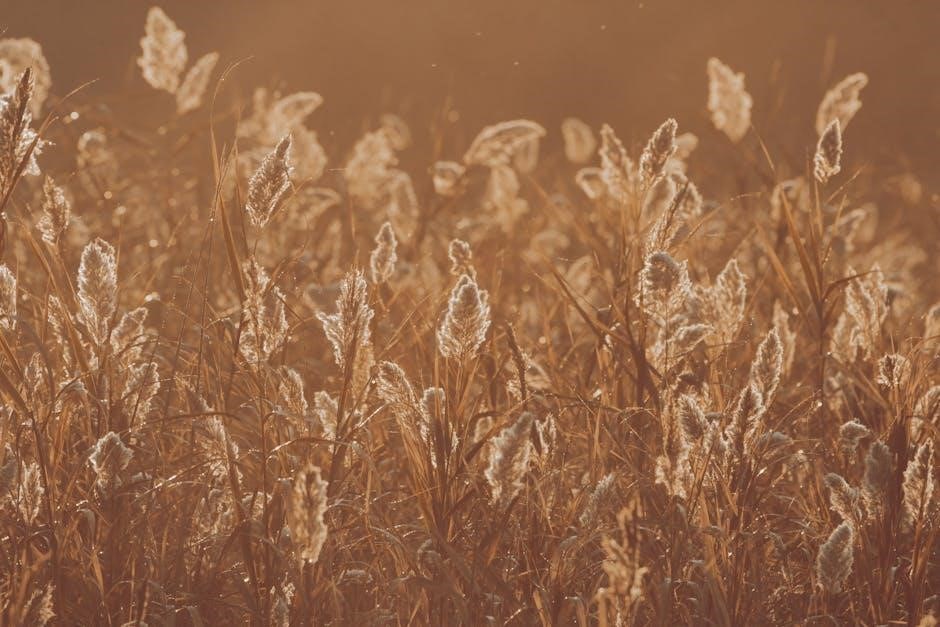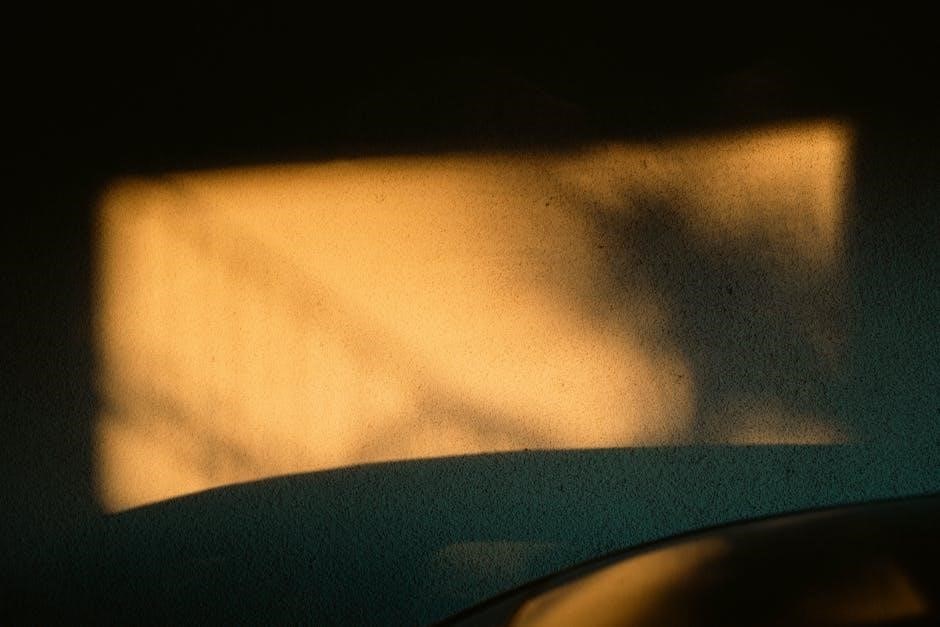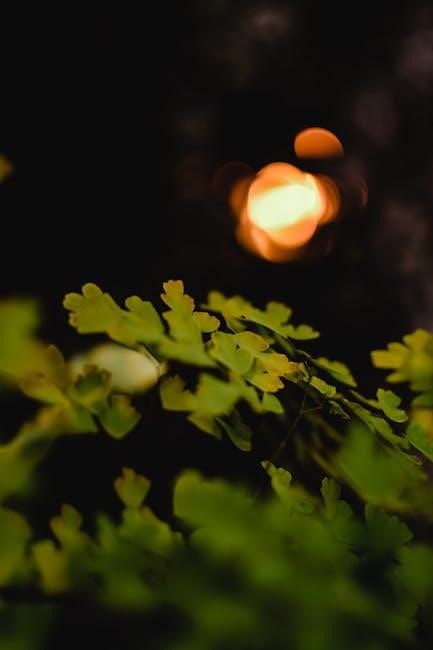The Golden Hour is a magical time around sunrise and sunset‚ offering soft‚ warm light ideal for photography‚ creating stunning images with ease and captivating beauty․
What is the Golden Hour?
The Golden Hour is the brief period shortly after sunrise and before sunset when the sun’s light takes on a soft‚ warm‚ golden hue․ This magical time transforms landscapes and subjects with gentle‚ diffused illumination‚ reducing harsh shadows and creating a serene atmosphere․ The light during this period is characterized by its warm color temperature‚ often displaying yellows‚ oranges‚ and reds‚ which add depth and emotion to photographs․ It occurs when the sun is low on the horizon‚ casting long shadows and bathing the scene in a magical glow․ This period is highly sought after by photographers for its ability to elevate imagery with unique aesthetic qualities and emotional impact‚ making it a cornerstone of outdoor and portrait photography․
Why is the Golden Hour Important in Photography?
The Golden Hour is a treasured moment in photography due to its unique lighting conditions․ The soft‚ warm glow reduces harsh shadows‚ creating a flattering light for subjects․ It enhances textures‚ brings depth to images‚ and adds a sense of warmth and emotion․ Photographers prize this time for its ability to transform ordinary scenes into extraordinary ones‚ making it ideal for portraits‚ landscapes‚ and urban photography․ The golden tones and gentle illumination provide a natural‚ ethereal quality that elevates the artistry of a photograph‚ making it a key element in capturing memorable and visually stunning imagery․

The Science Behind the Golden Hour

The Golden Hour occurs when the sun is low‚ scattering shorter blue wavelengths‚ leaving longer red and orange wavelengths․ This phenomenon‚ driven by Earth’s atmosphere‚ creates the warm‚ soft light photographers adore‚ with Kelvin temperatures around 1800-2000K‚ enhancing the emotional and aesthetic impact of images․
The Sun’s Position and Light Scattering
The Golden Hour occurs when the sun is near the horizon‚ causing sunlight to travel through more of Earth’s atmosphere․ This longer path scatters shorter blue wavelengths‚ enriching the remaining light with warm orange and red tones․ The low sun angle minimizes harsh shadows and creates soft illumination‚ ideal for photography․ Scattering intensifies as the sun dips lower‚ painting the sky in vibrant hues․ This natural phenomenon is fleeting‚ lasting about 60 minutes‚ making it a cherished moment for capturing stunning imagery with unique lighting conditions that enhance both portraits and landscapes․
How Kelvin Temperature Affects Photography
During the Golden Hour‚ the sun’s light transitions from daylight to warmer tones‚ with Kelvin temperatures ranging from 1800K to 3000K․ Lower Kelvin values produce softer‚ reddish hues‚ while higher values yield warmer‚ yellower tones․ This shift significantly impacts photography‚ as it creates a dynamic color palette․ Photographers can leverage these temperature variations to evoke distinct moods—soft‚ warm tones for portraits and rich‚ vibrant colors for landscapes․ Understanding Kelvin temperature helps photographers adjust settings and composition to capture the desired aesthetic‚ enhancing the emotional and visual impact of their images during this magical time of day․
Best Times to Capture the Golden Hour
The Golden Hour occurs shortly after sunrise and before sunset‚ offering photographers a window of soft‚ warm light perfect for capturing stunning images with minimal effort required․
Morning Golden Hour: Tips for Early Shoots
Capturing the morning Golden Hour requires early preparation․ Set your alarm to rise before sunrise and scout locations in advance to ensure optimal lighting conditions․ Use a tripod for stability‚ as low light may necessitate longer exposures․ Shoot in RAW format to retain image details and experiment with warm tones to enhance the ethereal glow․ Consider backlighting or side lighting to add depth to your subjects․ Be patient‚ as the light evolves rapidly during this brief window․ These tips will help you make the most of the serene and artistic morning Golden Hour for your photography․
Evening Golden Hour: Timing and Location
The evening Golden Hour‚ just before sunset‚ offers warm‚ soft light perfect for photography․ Timing varies by season and location‚ typically lasting 30-60 minutes․ Use apps to track exact times․ Scout locations in advance to find spots with unobstructed views of the horizon․ Coastal or open areas often yield stunning results․ Arrive early to prepare and experiment with compositions․ The descending sun creates long shadows and enhances textures‚ adding depth to your shots․ Be ready to adapt as the light changes rapidly․ This magical time is ideal for capturing portraits‚ landscapes‚ or cityscapes with a warm‚ golden hue‚ making it a favorite among photographers․

The Impact of Golden Hour on Photography

The Golden Hour transforms photography with its soft‚ warm light‚ reducing harsh shadows and infusing images with a magical‚ ethereal quality that captivates the viewer․
Soft Light and Warm Tones
During the Golden Hour‚ the sun’s low position creates soft‚ diffused light with warm tones‚ reducing harsh shadows and producing a gentle‚ flattering glow․ This light enhances textures and colors‚ making it ideal for capturing vibrant yet natural images․ The warm hues‚ often golden or orange‚ add depth and emotion to photographs‚ creating a serene and inviting atmosphere․ This unique lighting condition is particularly beneficial for portrait and landscape photography‚ as it softens facial features and brings out the natural beauty of the environment․ The soft light and warm tones of the Golden Hour are unparalleled‚ making it a favorite among photographers seeking to create visually stunning and emotionally engaging images․
Emotional and Aesthetic Impact in Photos
The Golden Hour’s soft‚ warm light creates a profound emotional and aesthetic impact in photography‚ evoking feelings of serenity‚ nostalgia‚ and wonder․ The golden hues and gentle illumination enhance the mood of images‚ making them feel more intimate and atmospheric․ This lighting adds depth and dimension to scenes‚ while its warm tones bring out vibrant colors and textures‚ creating visually striking compositions․ The ethereal glow of the Golden Hour often captures the essence of a moment‚ making photos feel timeless and emotionally resonant․ Whether in portraits or landscapes‚ this magical light transforms ordinary subjects into extraordinary works of art‚ leaving a lasting impression on viewers․

Techniques for Capturing the Golden Hour
Mastering the Golden Hour involves using its soft‚ warm light to create depth‚ minimizing harsh shadows‚ and experimenting with angles to enhance compositions and textures naturally․
Preparation: Location Scouting and Timing
Preparation is key to capturing the Golden Hour effectively․ Start by scouting locations in advance to identify spots that align with your creative vision․ Consider the terrain‚ obstacles‚ and how the light will interact with the environment․ Timing is equally crucial‚ as the Golden Hour is brief‚ lasting about 60 minutes before sunrise and after sunset․ Use apps or sunrise/sunset calculators to plan your shoots accurately․ Arrive early to test compositions and lighting setups․ Familiarize yourself with the location’s lighting patterns to maximize the short window of golden light․ Proper preparation ensures you’re ready to seize the moment when the magic begins․
Execution: Camera Settings and Composition
During the Golden Hour‚ precise camera settings and composition are essential for capturing stunning imagery․ Use a lower ISO‚ typically between 100-400‚ to minimize noise․ A wide aperture like f/2․8 or f/4 allows for a shallow depth of field‚ blurring backgrounds while keeping subjects sharp․ Experiment with white balance settings to enhance warm tones‚ often using the “Cloudy” or “Shade” presets․ Pay attention to composition by placing subjects near the golden light‚ leveraging leading lines‚ and incorporating reflective surfaces to amplify the warm hues․ Bracket your shots to capture a range of exposures‚ ensuring detail in both highlights and shadows․ These techniques will help you make the most of the golden light‚ resulting in visually compelling photographs․
Golden Hour in Different Photography Genres
The Golden Hour enhances various photography styles‚ from portraits to landscapes‚ offering unique lighting opportunities that elevate creativity and produce captivating‚ genre-specific visual effects naturally․
Portrait Photography: Leveraging Golden Hour Light
Golden Hour light transforms portrait photography‚ offering soft‚ warm tones that highlight subjects naturally․ The low sun creates flattering shadows‚ reducing harshness and enhancing skin tones․ Photographers can use this light as backlight‚ side light‚ or front light‚ providing versatility in composition․ The golden hues add depth and emotion to images‚ making portraits feel more intimate and authentic․ This magical time is ideal for capturing candid moments‚ as the soft illumination minimizes unflattering highlights and shadows‚ resulting in polished‚ professional-looking portraits with minimal post-processing needed․ It’s a favorite among photographers for creating timeless‚ ethereal images that stand out․
Landscape and Urban Photography: Unique Opportunities
The golden hour offers unparalleled opportunities for landscape and urban photography‚ casting a warm‚ ethereal glow over scenes․ For landscapes‚ the soft light enhances textures and colors‚ creating dramatic skies and long shadows that add depth․ In urban settings‚ the golden hour transforms cityscapes‚ highlighting architectural details and reflecting off surfaces with a magical ambiance․ The low sun angle brings out vibrant hues‚ making even familiar locations look fresh and captivating․ This time is ideal for capturing dynamic range‚ from the glow of streetlights to the brilliance of the setting sun‚ allowing photographers to create visually striking and emotionally resonant images in both genres․
The Golden Hour is a magical time with soft‚ warm light‚ perfect for sunrise and sunset photography․ It offers creative freedom and stunning results‚ making it a favorite among photographers․

Final Tips for Mastering the Golden Hour
Mastery of the Golden Hour begins with preparation․ Scout locations beforehand to ensure optimal lighting and composition; Adjust your camera settings to capture the full dynamic range‚ using lower ISOs and wider apertures․ Experiment with different angles and perspectives to harness the unique soft‚ warm tones․ Pay attention to the color palette‚ emphasizing yellows‚ oranges‚ and reds․ Shoot in RAW format to retain detail and flexibility in post-processing․ Practice patience‚ as timing is crucial—arrive early for sunrise and stay late for sunset․ Embrace the unpredictability of light and enjoy the creative freedom this magical hour offers․ Remember‚ consistency and practice will refine your skills‚ making you a Golden Hour expert․
Encouragement to Experiment and Explore
Embrace the Golden Hour as a canvas for creativity․ Each shoot is an opportunity to experiment with new techniques‚ from composition to lighting setups․ Don’t be afraid to try unconventional angles or subjects—this is where unique stories unfold․ Explore different genres‚ whether portraits‚ landscapes‚ or urban scenes‚ to discover how Golden Hour transforms each․ Remember‚ every sunset and sunrise is unique‚ offering fresh chances to innovate․ Share your work‚ seek feedback‚ and learn from others’ experiences; The Golden Hour is not just a time of day; it’s a journey of artistic growth and endless possibilities waiting to be captured․
